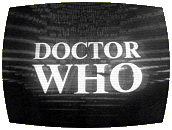 After leaving Victoria on Earth, the Doctor and Jamie find themselves aboard a drifting spacecraft. A fault in the TARDIS’ mercury fluid link creates a dangerous malfunction, which the Doctor resorts to drastic measures to stop, removing the timeship’s time vector generator and folding down its internal dimensions until it literally is a police box. The Doctor is knocked out as the spacecraft lurches suddenly, leaving Jamie on his own. When the ship comes dangerously close to space station W3, the station’s commander prepares to blast the ship out of the sky, over his crew’s objections. Jamie manages to signal the space station, which sends astronauts across to retrieve the two time travelers, who find themselves hard-pressed to explain their presence. The ship is millions of miles off course and shouldn’t have been anywhere near W3 at all. When a Cybermat appears, the Doctor realizes that the Cybermen can’t be far behind – and they’ve used the ship to smuggle themselves aboard the wheel. But what is the Cybermen’s real goal?
After leaving Victoria on Earth, the Doctor and Jamie find themselves aboard a drifting spacecraft. A fault in the TARDIS’ mercury fluid link creates a dangerous malfunction, which the Doctor resorts to drastic measures to stop, removing the timeship’s time vector generator and folding down its internal dimensions until it literally is a police box. The Doctor is knocked out as the spacecraft lurches suddenly, leaving Jamie on his own. When the ship comes dangerously close to space station W3, the station’s commander prepares to blast the ship out of the sky, over his crew’s objections. Jamie manages to signal the space station, which sends astronauts across to retrieve the two time travelers, who find themselves hard-pressed to explain their presence. The ship is millions of miles off course and shouldn’t have been anywhere near W3 at all. When a Cybermat appears, the Doctor realizes that the Cybermen can’t be far behind – and they’ve used the ship to smuggle themselves aboard the wheel. But what is the Cybermen’s real goal?
written by David Whitaker
from a story by Kit Pedler
directed by Tristan de Vere Cole
music by Brian Hodgson and the BBC Radiophonic WorkshopGuest Cast: Freddie Foote (Servo-Robot), Eric Flynn (Ryan), Anne Ridler (Dr. Corwyn), Clare Jenkins (Tanya Lernov), Michael Turner (Bennett), Donald Sumpter (Enrico Casali), Kenneth Watson (Duggan), Michael Goldie (Laleham), Derrick Gilbert (Vallance), Kevork Malikyan (Rudkin), Peter Laird (Chang), James Mellor (Flannigan), Jerry Holmes, Gordon Stothard (Cybermen), Peter Hawkins, Roy Skelton (Cybermen voices)
Notes: Portions of this episode were destroyed by the BBC in the early 1970’s; the two surviving episodes appear on the Lost In Time DVD set. This episode marks the first appearance of the Doctor’s nom de plume, “John Smith”, which would be used more frequently in the Pertwee era and would reappear in everything from the 1996 TV movie through David Tennant’s tenure. Jamie coined the name in a bit of a pinch, and perhaps as a payback, the tenth Doctor instead uses the alias “James McCrimmon” during a visit to Scotland in Tooth And Claw. Zoe joins the TARDIS crew in this story, and the end of episode six the Doctor sets up a device to replay a recent adventure with the Daleks to her, which was an inspired way to lead into a rare rerun (in this case, The Evil Of The Daleks). This marked the final appearance of the Moonbase-style Cybermen; in their next appearance, in The Invasion, they would undergo a major redesign.
Broadcast from April 27 through June 1, 1968
LogBook entry & review by Earl Green
Review: The last gasp of the Golden Age Cybermen, The Wheel In Space is a curious throwback to an earlier era of Doctor Who. In large part, this is thanks to a script by the show’s original script editor, David Whitaker, who falls back on the kind of bizarre pseudoscience that was woven into the earlier scripts he oversaw. As with The Daleks, the TARDIS is crippled by a lack of liquid mercury (an oddly mundane dependency for such a fantastic craft), and while I give Wheel big points for one of the first filmed portrayals of a torus-style space station, as imagined by space visionary Gerard K. O’Neill, the story leans heavily on talk of wayward rockets and dialogue and characters that, even by the standards of late ’60s Doctor Who, are absurdly cliched and sexist. It’s almost a throwback to 1950s pulp sci-fi, giving us such howlers as “All spacemen are protected from brain control by drugs!” (Wheel is also the source of the infamous made-it-onto-the-air blooper in which the Doctor mentions the “sexual air supply” when he means “sectional”; talk about making love out of nothing at all – you’re breathing it, baby!)
It’s also a throwback to the early, produced-year-round days of Doctor Who, with the Doctor out of commission for much of the first half of the story, apparently due to little more than a tap on the head (a plot development inspired more by Patrick Troughton’s request for some time off than anything). Jamie carries this half of the story, though it seems like there’s wasted potential in following him as he tries to make his own way in the distant future to which he is unaccustomed. The Cybermen are used strangely here too, having suddenly developed the ability to control human minds and utilizing an invasion plan that seems to depend on coincidence as much as anything. And in any case, the story waits until it’s almost over to nail down the importance, strategic or otherwise, of the station, and therefore why the Cybermen would go to such lengths to take it over – and even when it is explained, it’s nonsense. The story’s logic falls down in other places as well, namely in the case of a character who spots a Cybermat on the space station, and bizarrely tries to snag it as a pet, but tells no one about it until it’s had a chance to sabotage the station. This could’ve been explained away simply by allowing the Cybermats to share the Cybermen’s newfound drug-resistant brain control ability.
Only two of the six episodes of Wheel survive in video form, and they don’t necessarily improve things. The Cybermen’s spacewalk to, and their subsequent repulsion from, the station is the product of an addled budget, and simply looks silly. Even The Moonbase made a better show of low gravity than this.
Wheel may be inordinately fondly remembered for introducing Zoe and for just being a Cybermen story, but this is easily the nadir of their 1960s appearances, and numerous elements of Wheel are so outlandishly silly that it’s hard for me to avoid dismissing it as one of the biggest clunkers of Troughton’s era. I can almost justify this story’s existence for the surviving clip of the Doctor turning slowly to face the Cybermen and saying “I imagine you have orders to destroy me,” a classic clip if ever there was one, but The Wheel In Space is best left rolling into obscurity.

